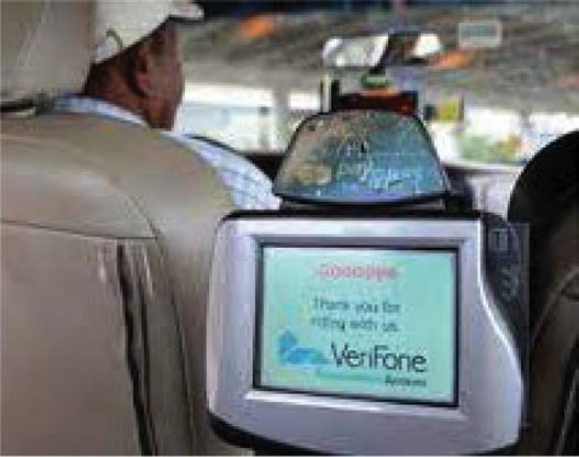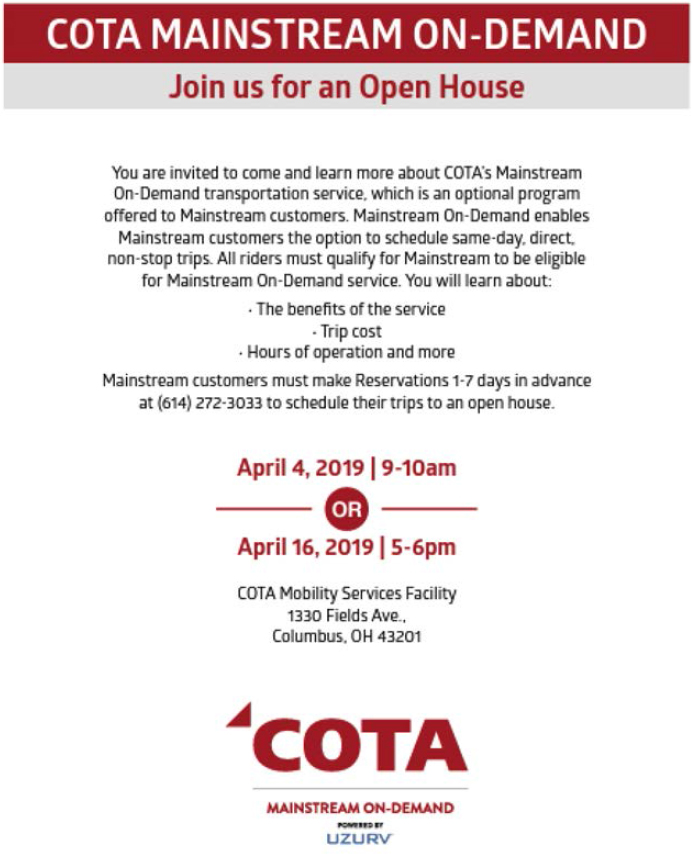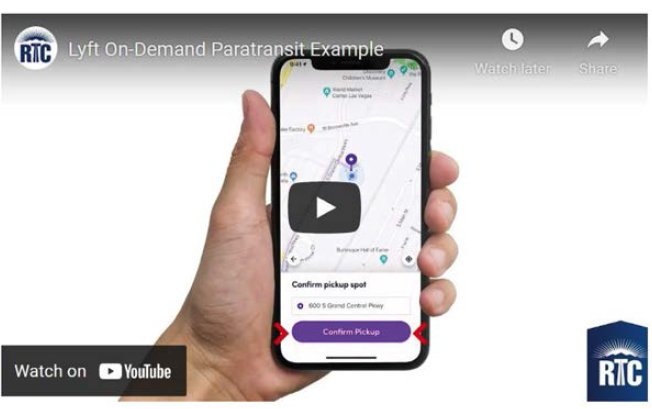
CHAPTER 4
Implementation
Implementation includes obtaining the provider or providers for the alternative service, agreeing on the service to be implemented, developing user information and marketing materials, and actual service start-up.
Procurement
Using an RFP to solicit interest from transportation providers for the alternative service is a typical first step toward implementation. An RFP allows you to specify and describe the service you are looking for and see which providers are interested and what they offer.
Following issuance of an RFP, a bidders’ conference allows interested bidders to ask questions to better understand the service requested, with clarifying answers from the transit agency helping providers determine if and how they will submit a response.
Several of the case study transit agencies used an RFP to solicit interested transportation companies to provide the transit agency’s alternative service (RFP examples are in Appendix B).
On the other hand, at least one of the surveyed agencies purposefully did not use an RFP and instead negotiated directly with two providers to launch its alternative service pilot program, and indicated that, at least at the start, it did not want formal contracts with the providers. This is often the case with user-side subsidy model designs, for example.
Note that an RFP provides an opportunity to negotiate terms for an eventual agreement with selected providers. For this reason, the RFP should include service level expectations/requirements and reporting requirements so the transit agency can determine the levels of performance provided and especially service equivalence. The RFP should also lay out the general design of the program, whether the transit agency is planning to contract with one provider or multiple providers, and driver-related requirements.
Seeking One Provider or More?
This project’s survey identified alternative service programs using only one provider and others using multiple providers. The latter was more common.
If there is only one provider, you must ensure that provider follows the FTA’s drug and alcohol testing requirements. With multiple providers, drug and alcohol testing is not required since riders have a choice of providers. Figure 4-1 identifies the three providers for Tri Delta Transit’s alternative service program.
Issue RFP
Issuing an RFP makes clear what the transit agency is seeking for its alternative service and what it expects from the provider(s). If you issued an RFI or had an informational meeting with providers in your community (as discussed in Chapter 3), their questions and feedback should be useful in crafting an RFP.
The RFP should describe your expectations, including, for example, the scope of services, service area and span, types of requests allowed, the fare and payment scheme, and the data that you want the provider(s) to report. Identifying the specific data you require is important, as data provision particularly from TNCs has been a challenge for some transit agencies.
Data
The transit agency needs data from its providers to monitor and evaluate the alternative service. The range of data that should be available will depend on the design of the alternative service, for

Figure 4-1. Tri Delta Transit’s Mobility on Demand program for paratransit customers uses three providers.
example, a user-side or a provider-side subsidy model (data from a user-side subsidy program is much more limited), whether an initial fare is charged, use of a payment card, and method for trip reservations.
For provider-side subsidy programs, a comprehensive collection of data from providers would include:
- Aggregated data
- Total passenger trips provided/subsidized
- Number of unique customers transported
- Total fare revenues
- Total cost (subsidy)
- Total revenue vehicle miles
- Total passenger trips by vehicle type (e.g., sedan versus WAV)
- Total passenger trips by service type (e.g., Uber versus UberPool)
- Total passenger trips by reservation option (e.g., call center, concierge, app/web, hail)
- Total passenger trips by reservation type (e.g., subscription, advance, same-day, immediate fulfillment)
- Total passenger trips by trip origin and trip destination (e.g., by zip code)
- Total passenger trips by day and time of day (e.g., hour by hour)
- Response time/on-time performance for immediate fulfillment trips (e.g., response time versus established standard such as 2 hours)
- On-time performance for other same-day, advance, and subscription trips (e.g., on-time arrival versus late arrivals as defined by transit agency; number and/or percentage of on-time completed trips)
- Response time/on-time performance broken down by trips served with sedans versus trips requiring WAVs
- Disaggregated data
- Data on passenger trip origins and/or destinations (e.g., by address or nearest intersection)
- Total passenger trips requested/served for each customer
- Details on passenger trips requested/served for each customer (e.g., including origin and destination, time, fare, on-time performance, no-shows, etc.)
For user-side subsidy programs, the following data, by provider, should be collected:
- Number of WAVs in fleet, if any
- Aggregated data
- Total passenger trips provided/subsidized
- Total transaction amounts
- Disaggregated data
- Each trip and transaction amount
Wheelchair-Accessible Service
Ensure the RFP addresses the need for wheelchair-accessible service. As discussed in Chapter 3, the transit agency can require providers to have WAVs. Otherwise, the transit agency must

Figure 4-2. Trip request options by phone for MBTA’s pilot alternative service.
ensure wheelchair service is available by contracting with a separate provider. According to FTA guidance, at least one provider must provide WAVs, or the transit agency may provide the WAV service using its own vehicles.
Trip Requests
If the service design has decentralized trip requests, the RFP must require that the providers have an option for riders to request a trip by phone. If you are using taxis as providers, the taxi company(ies) will typically have a call-in option already. For TNCs, which rely mostly on apps to request service, transit agencies will typically request that the TNC provide back-up call-in capabilities with a concierge link to the TNC’s system. Some transit agencies also use their paratransit call center for this purpose. Figure 4-2 depicts the trip request options available for the MBTA’s alternative service.
Trip Payment
Rider payment is another topic to be addressed in the RFP. Taxis generally accept both cash and debit/credit cards. TNCs generally do not accept cash. Therefore, there must be an option for unbanked riders to pay a fare on a TNC-based system. Riders without a credit/debit card commonly use a prepaid debit/cash card.
With most provider-side model alternative services, the rider’s debit/credit card is debited when the trip is completed; at this point, the amount paid includes the base fare (if any) and any overage (over the portion covered by the base fare and transit agency subsidy). The rider also has the option to pay a tip in this fashion.
With many user-side subsidy model alternative services, riders use a fare payment card supplied by the fare card technology vendor or a credit card issued by a partnering bank where the use of the card is limited to a certain type of vendor (such as taxis and limousines). In these cases, the transit agency loads funds into the rider’s account monthly, matching in some fashion the funds the rider loads into the fare account. With the card account fully loaded, the rider pays the total fare (transaction) at the end of each trip (at the destination point). The rider can continue to take rides as long as there are sufficient funds in the card account. Some systems allow the use of this card to pay a tip. Figure 4-3 shows an onboard device for fare payment.

Figure 4-3. Backseat point-of-sale device.
Consult with Legal and Risk Management
Preparing the RFP should include consultation with your transit agency’s legal and risk management departments.
Negotiate
Be willing to negotiate with responsive providers. There may be issues that require discussion and compromise, especially on data reporting. While it’s important to obtain the data your transit agency needs to monitor and evaluate the alternative service, negotiation may mean you do not get every data element you would like. And according to Boston’s MBTA, that’s okay.
Start Slowly
Rather than introducing the alternative service as a new program to all eligible riders at once, it may be wise to start more slowly. The research found that transit agencies have done this by starting as a pilot available to all riders or to a selected subset of riders.
Start Service as a Pilot
Consider whether the alternative service should start as a pilot. The advantage of a pilot is that revisions and changes can be made as experience is gained before the service is a formal offering by the transit agency. It is easier to make revisions and changes if the service is branded as a pilot.
Leaving the end date of the pilot open is another strategy that may be effective; you may need longer than anticipated to gain the experience you want.
If starting as a pilot, it’s a good idea to advertise this to riders and the disability community so they understand the service as implemented may see changes and may not be permanent.
Of the alternative services reviewed through the research, 12 began as pilots.
Start with a Subset of Riders
Several of the surveyed transit agencies began their pilot with a subset of riders before opening the service up to all eligible riders. This might involve announcing the program as a small pilot and limiting the number of riders to the first X to register, or you may select certain riders based on a criterion (such as frequent users).
This is essentially a pretest of the service and gives both the transit agency and the selected riders experience with the new transportation program. Particularly for the transit agency, this experience can be useful for adjusting or fine-tuning the service. Feedback from the participating riders can be instructive to assess their experience and understand if the user information is effective.
Also, the transit agency may find it needs to provide staff resources to help registrants with the pilot service, whether to help them download a TNC app or apply for a fare payment card at a bank.
Contract
Once you have finalized negotiations and have a firm agreement for the service to be provided and your transit agency’s expectations, finalize the contract document. Ensure the service as specified in the contract complies with regulation for the provision of an alternative service (see Chapters 3 and 8). If, for example, you will contract with a provider that is not providing WAV service, be sure to involve at least one other provider that does operate WAV service. Sample contracts are in Appendix B.
Contract Document
In addition to the standard contract clauses and as advised by the transit agency’s legal counsel, risk management, and procurement, a contract with providers for an alternative service should include:
- Scope of service
- Service area
- Service span
- Rider eligibility—how will the transit agency inform providers of rider eligibility and with what frequency?
- Trip request process
- Performance standards
- Data requirements
- Vehicles
- WAVs?
- Drivers
- Qualifications and training?
- Complaints
- What is the responsibility of providers for complaints and complaint resolution?
- Payment arrangement
- How will the provider be paid for trips provided?
- What about no-shows?
- If riders pay an initial fare, how is that amount calculated against the trip reimbursement?
- What about tipping?
- Insurance
When you have an executed contract, discuss the timeline for service start-up.
Timeline
Once you have agreements with the providers you can plan for service start-up, whether that’s a pilot open to all paratransit riders or to a subset of riders.
An important effort before start-up is developing rider information and marketing materials. Outreach and discussion with your disability advisory group should also be conducted so members know the service is coming.
User Information and Marketing Materials
User information and marketing materials need to make clear the distinction between the on-demand service and ADA paratransit. This may require more than information on the website, with targeted outreach to eligible riders during the early start-up period to ensure they understand what the alternative service is and what it is not, and how to register for and access it. An open house is one option to introduce an alternative service to the riders; see Figure 4-4.
Part of introducing your riders to the on-demand service may be helping them learn how to use an app on a smartphone. RTC, the transportation agency serving Las Vegas, created a video to help its paratransit riders use the Lyft app; see Figure 4-5.

Figure 4-4. COTA held an open house to help introduce its alternative service, Mainstream On-Demand, to riders.

Figure 4-5. RTC’s video guide.
Service Start-Up
Determine the go-live date; perhaps it should be a go-live week rather than one day. Adjust the marketing materials to target riders eligible for the start-up, whether that is a subset of riders or all riders. It is preferable to delay a highly publicized new service campaign until some early experience has been gained.
Start the service slowly, allowing a gradual buildup of use by riders. Gradual ridership growth lets providers adjust to the new trip demand. Marketing efforts should be designed and implemented in concert with the early experience with the alternative service.
Checklist
□ Determine whether your agency should issue an RFP for the alternative service or negotiate directly with potential transportation providers.
□ For RFPs, hold a bidders’ conference to allow prospective transportation providers to ask questions and gain a better understanding about the service to be provided.
□ For RFPs, give information on expectations for the service, including needs for data, wheelchair-accessible service, trip requests, and trip payments.
□ Consult with your agency’s legal and risk management departments while preparing the RFP.
□ Determine whether to use one provider or multiple providers for the alternative service.
□ Be willing to negotiate with prospective providers on the service specifics, compromising when possible while securing definitive needs for your agency.
□ Consider scaling down the available service eligibility at the beginning or starting the alternative service as a pilot to allow room for revisions and adjustments to the service before it is implemented at a wider scale.
□ Finalize the contract document with the transportation provider(s) and include specifics on regulatory compliance for the service.
□ Specify a timeline for service implementation that considers needs for disseminating user information and marketing materials sufficiently in advance.
This page intentionally left blank.










